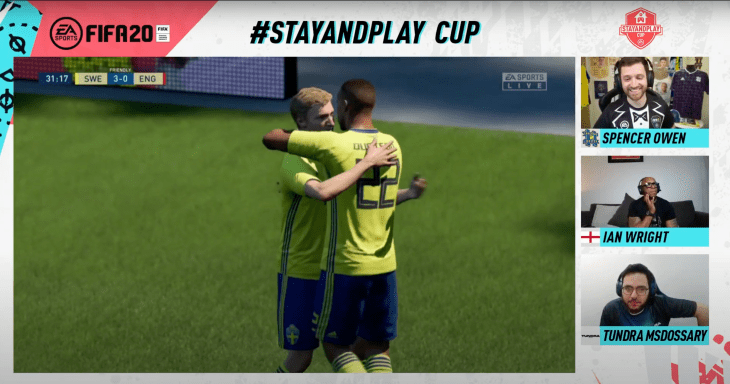The COVID-19 pandemic has wiped out the spring seasons for professional sports and associated revenue for TV networks, but esports is filling part of that void.
Gaming companies behind titles licensed by each major league are the winners in this unexpected shift. Electronic Arts (EA) is first among them with FIFA, Madden NFL, NBA Live and NHL in its EA Sports portfolio and more than 100 esports events planned for 2020. The way EA, networks and sports leagues are responding to production challenges in this crisis will reshape the esports market going forward.
Millions of people sheltering in place has created a breakout opportunity for esports broadcasting:
- A large portion of the internet-using population is at home 24/7, with screens as their main entertainment outlet.
- Sports fans have few competitive live events to watch.
- Broadcasters like ESPN, CBS, and Sky lost their most valuable content for attracting live viewers and need alternative content.
- Star athletes and non-sports celebrities are stuck at home with wide-open schedules.
In late March, 900,000 viewers tuned into Fox Sports for Nascar’s iRacing series, with 1.1 million watching in early April; the network has also broadcast Madden NFL tournaments with NFL commentators and athletes. ESPN is televising NBA players facing off against each other in NBA 2K (by Take-Two Interactive) and pro drivers (and other pro athletes like Manchester City striker Sergio Aguero) are racing each other in Codemasters’ F1 2019 game. ESPN has broadcast competitive play of non-sports games with League of Legends (by Riot Games) and Apex Legends (by EA) tournaments.
To be clear, ratings for these events have varied widely, but networks and game companies are rethinking how esports is broadcast, which will advance its pop culture appeal.
Games adapting pro sports are best bridge to non-gamers
Esports is a massively popular activity with its own large piece of turf in pop culture, but it hasn’t secured a central role. Research firm Newzoo pegs the global audience of “esports enthusiasts” at 223 million. But unlike soccer and basketball, esports is siloed because it caters to viewers who are generally avid gamers. The action is extremely fast, so commentary by a streamer rarely helps outsiders understand what is going on enough to become engaged.
“Going mainstream means you don’t have to have been a video game player to understand and enjoy it,” says EA SVP Competitive Gaming Todd Sitrin. Broadcasting games that adapt professional sports bridges the gap between esports’ limited popularity and the breadth of appeal that Sitrin defines as mainstream. As he said in our recent interview, most people are familiar with professional sports’ rules and already have emotional connections to different teams, which helps give them a stake in the outcome of an esports match.
Demographics suggest that a majority of professional sports fans will not turn to watching esports regularly, given the average age of TV viewers: 50 for the NFL, 57 for Major League Baseball, 58 in Nascar and 61 in men’s tennis. Younger sports fans are the most likely new additions, and adaptations of real-world sports are a much more effective bridge to them than other games.
Esports-native production

Sitrin says no one in broadcasting has had the ability to produce shows where all staff and participants are 100% remote, but his staff worked over a two-week sprint in March to create a fully cloud-based production and workflow system to do precisely that, based in part on existing solutions. The first broadcast to use their system was an APEX Legends tournament on March 23.
Circumstances forced EA to produce tournaments as a new type of live entertainment experience. Because competitions take place in a virtual world, games on streaming platforms like Twitch and YouTube Gaming use a close-up of the player’s face, which allows them to double as a commentator who interacts with teammates and audience members. It makes sense for esports TV broadcasts to draw more from these popular streams than traditional coverage of in-person sports events.
Game streaming brings a more intimate exposure to the star, which is what’s exciting audiences right now with celebrities as commentators and competitors in games like NBA 2K and FIFA. Sitrin says EA is doubling down on this deeper intimacy based on feedback it has received from fans who like seeing their favorite stars talking casually from home where their background conveys more of their personality.
These reality-show tactics make broadcasts more entertaining and emotionally compelling to broader audiences; people who aren’t hardcore gamers don’t care as much about seeing the highest caliber of esports competition. Sitrin said EA purposely pairs famous commentators like retired Arsenal player Ian Wright with an experienced esports broadcaster as co-hosts and are experimenting with more strategies to foster excitement when all participants are video-conferencing in. Esports broadcasts are being redesigned as their own format of entertainment that is not constrained by the best practices of sports broadcasting.
The esports engagement funnel

Image Credits: Electronic Arts
For most people who pick up a controller, games are a fun, shared experience, not a serious pursuit to study and train for. The casual gaming experience, when it involves entertaining personalities, is more entertaining than serious esports competitions for a large segment of people. Aside from one dedicated esports TV channel, broadcasting competitive video gaming is about exposing it to a broader audience than would watch on Twitch. In fact, hardcore gamers who double as core esports fans almost certainly have a harder time trying to watch esports on ESPN or Fox Sports given the small (and ever declining) percentage of young people who pay for cable TV.
What EA’s broadcasts demonstrate are a better approach to building the top of the esports engagement funnel. People’s existing interest and emotional connection is with pro athletes and sports teams, plus other non-sports celebrities, so orienting competitive (video) gaming around those VIPs and team franchises entices new viewers to watch. That entices a portion of viewers to play more of the video game themselves and watch more skilled players than the celebrities. (This also applies to press, who will watch and write about pro athletes and celebrities’ esports matches but wouldn’t tune in otherwise.)
Sports games are the most natural pioneers of esports on broadcast TV because they are merely a virtual recreation of existing TV content with a devoted fanbase. Given the massive popularity of games like Fortnite, League of Legends and Apex Legends, there is a large, established fanbase for esports competitions with those titles if a TV network can aggregate those fans. Twitch and other live streaming sites will remain better distribution channels, but television networks can succeed in broadcasting competition between celebrities with slower gameplay, simpler explanation and more exposure of the participants’ personalities.
Next stage of esports broadcasting
Normal sports programming will return to TV within the next two months, albeit in empty stadiums. So what is the lasting impact?
- There will be less focus on broadcasting in-person esports tournaments. In-person events will remain a part of the market because filling an arena with fans is profitable (in ticket sales and merchandise) and great for community-building among core gamers. But broadcasts can be equally or more entertaining when entirely crafted for TV audiences and require a fraction of the amount of upfront effort and cost to organize. Publishers that want to sell more games and TV networks looking to incorporate esports programming will focus on producing casual, celebrity-involved tournaments where competitors are remote.
- Competitive gaming between celebrities will grow as a category of shows on TV and game-streaming platforms. This format has low production costs and can attract the younger viewers advertisers are seeking. Sitrin says one of the lessons he’s learned is that many celebrities would be willing to compete in esports if their commitment was just for 30 minutes each week from anywhere with a great internet connection. “Pro athletes love competing in general,” he told me, “give them an easy way to compete in video games and many will be eager to.” It’s a sentiment echoed by Dallas Mavericks owner Mark Cuban in a recent interview: “I had no idea so many [NBA players] were gamers. I knew we had a few guys, but it seems like it’s every player!”
- Professional sports franchises will take greater interest in developing their own esports operations to use as additional marketing channels and revenue streams. Most of the current esports initiatives by pro sports franchises entail them funding a team of pro gamers. Often the team competes in games other than the official sports game of the league; this was done amid esports hype as an attempt to innovate but it has no synergy with the core business of the franchise. Alternatively, having an esports team that competes as your franchise in the relevant sports game will only have increasing value as esports becomes more widely popular. Given the first two points above, franchises will be better able to bridge the fandom around their core team and fandom for their esports team with a middle layer of competitive gaming involving star athletes and celebrities in casual esports competitions.
- TV networks will embrace esports as regular programming, but their relevance to esports’ growth will be short lived. Live sports is one of the reasons why many consumers maintain expensive cable subscriptions in the era of streaming options like YouTube TV, Hulu with Live TV and FuboTV. Without it, the collapse of pay-TV market would accelerate (in the U.S., AT&T loses about 1 million pay-TV subscribers per quarter with a current base of 18.6 million, for example). That’s why the cost of exclusive broadcast rights for pro sports has increased even as audience size has decreased. Fans of esports similarly want to watch live competitions. Broadcasting better-produced esports will bring a short-term benefit to gaming and TV networks through broader audience exposure and pop culture positioning.
Ultimately, game streaming platforms like Amazon’s Twitch, YouTube Gaming, Microsoft’s Mixer and Facebook Gaming are better hubs for both casual, celebrity-involved esports competition and serious pro esports competition than ESPN, Fox Sports or any other TV network. They are easier to access (no cable subscription required), built specifically for fan interaction around esports, and — with hundreds of millions of monthly active users each — already have equal or better distribution to reach relevant consumers than top TV networks.
Esports is finally securing its place as a big part of overall pop culture in Western countries. Higher production values and televising interactions between celebrities and players elevates esports stars to broader celebrity status in the process. Publishers will gain from increased game sales, in-game purchases and higher prices for exclusive streaming and broadcast rights.
Two years from now, people will look back at 2020’s COVID-19 lockdown as a pivot point in esports’ development.

